Travel to Australia and you can see the towering Bunya-Bunya tree, which looks like a pine tree from a distance but has leaves with sharp points that resemble a succulent close-up. Female versions of the Bunya-Bunya tree produce football-sized cones that are celebrated by the Bunya Festival.
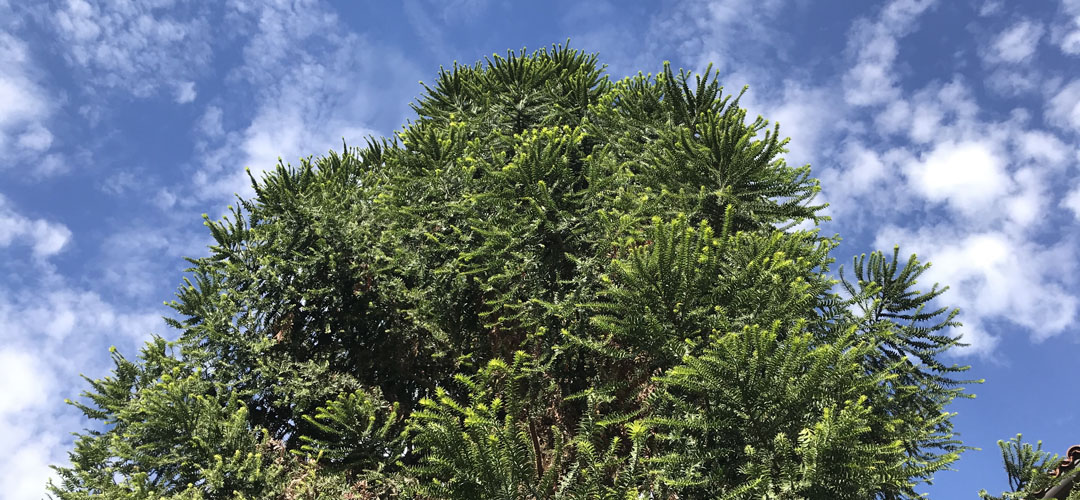
Looking up at the Bunya-Bunya tree on the University of Arizona Campus
While we don’t have a festival, we do have a Bunya-Bunya tree here in Arizona – in fact, right in the middle of Tucson on the University of Arizona Campus Arboretum grounds. (Click on any of the tree names to see more information and pictures from the University of Arizona). You can see this tree at any time, but I might not have noticed it except that it was pointed out to me on one of the Arboretum’s free tree tours. The specific tour that I participated in was called “Trees Around the World,” and that, indeed, is what we saw.

From left to right: The Bunya-Bunya tree grows tall on campus and looks like a pine tree from a distance, a plaque with a QR code describing the tree, and a close-up of the unique needles
Some trees, like the Aleppo pine, you’ll see all over Tucson, as they have adapted well to our climate.

The Aleppo Pine grows well in Tucson and can be recognized by the cones that stay on the tree year-round. In the middle picture, our volunteer Master Gardener guide, Tony, showed a picture of Old Main before anything was planted. You can see the current Old Main building in the background.
Others, however, have the only known species in the state "hidden" on the University campus, in plain sight for hundreds of students and faculty every day.
My tour took place on a beautiful Saturday morning in November – the same day as the Homecoming parade and game, it turns out. So we enjoyed the sounds of the marching band as we wandered from tree to tree, exclaiming over the height of some, the unique features of others.

From left to right: 1) The trunk of an eucalyptus tree, 2) the top of a tall eucalyptus tree (they can grow 40 feet in just 20 years!) 3) a group of date palms, 4) the edible dates that they produce, and 5) the berries from a Firethorn tree
If you don’t know, the arboretum is not a separate part of the University of Arizona Campus – it is the campus itself. We walked on the U of A mall, around Old Main, to the Engineering building, several residence halls, the Communications building, and by the Arizona State Museum.
The entire campus is covered in trees, and the number - and diversity - of tree species is one of the reasons that it was named a Tree Campus USA in 2010.
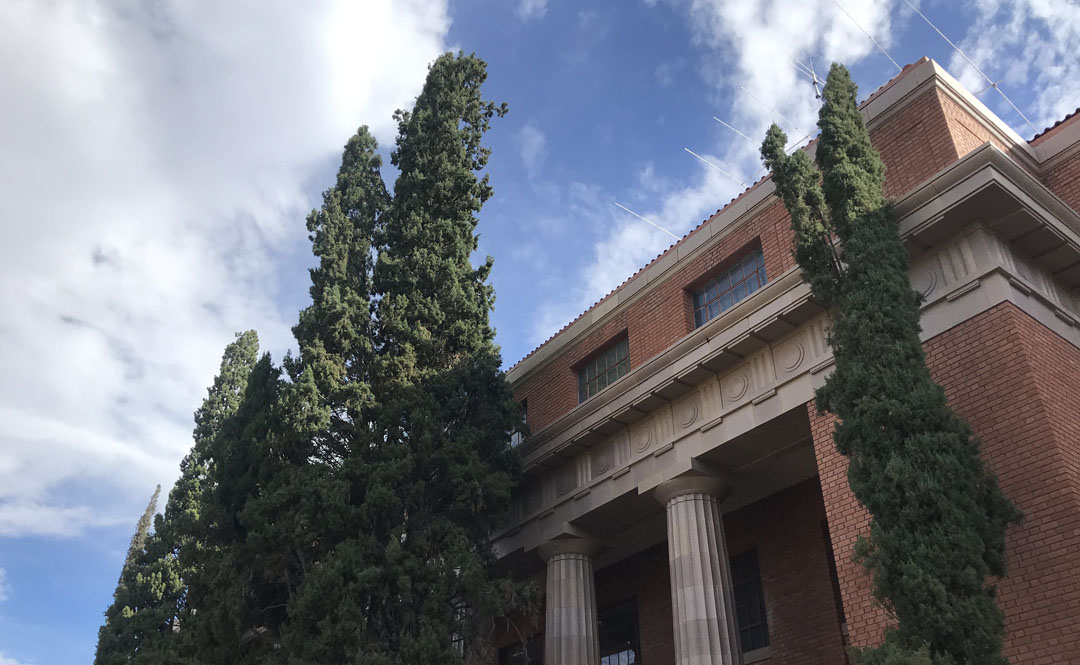
Italian cypress trees on the University of Arizona Campus
Whether you know a lot about trees or practically nothing, these tours will inspire an appreciation for the variety of trees found on the U of A campus. While the tour that I went on covered non-native trees that won’t work in most Tucson-area yards, we also stopped by trees like the Desert willow to admire its branches, and spent some time discussing whether a saguaro cactus, a yucca plant, and an aloe plant all count as succulents (spoiler alert: they do).
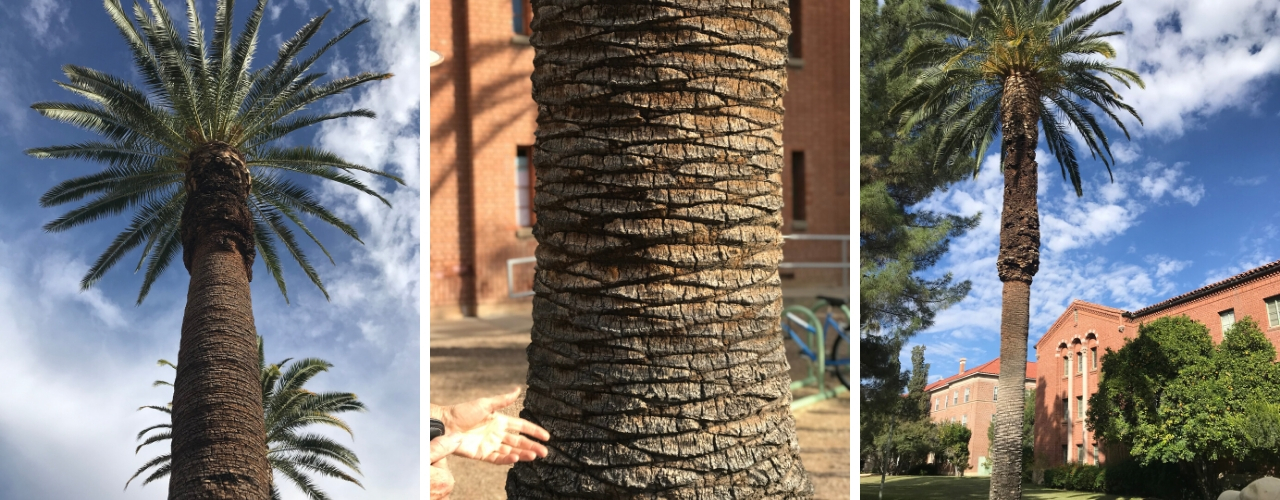
Canary Island date palm trees have a unique diamond pattern on their bark.
I can now (possibly) tell the difference between a California fan palm, a Mexican blue palm, and a Canary Islands palm if I see one around town, can say that I have seen a cork oak tree (where wine corks come from), smelled the peppery seeds from a chaste tree, and tasted the fruit of a Calamondin tree, which looks like a tiny orange or a kumquat (it’s a hybrid of a kumquat and a mandarin orange) but has a sweet skin and an especially tart center.
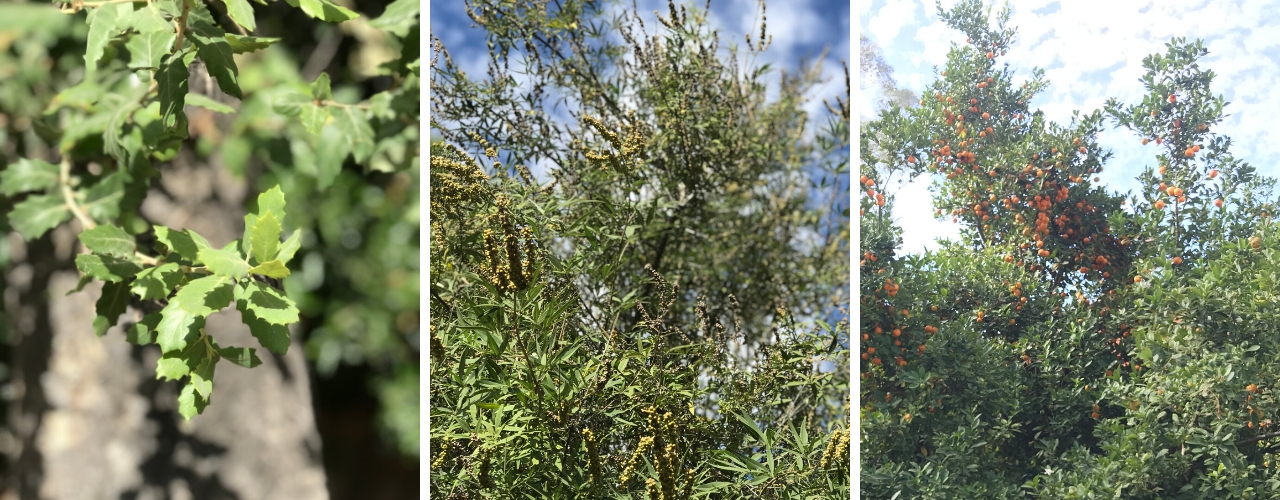
From left to right: the leaves of the cork oak tree, the seeds of the chase tree, and the fruit of the calamondin tree
Of course, if you don’t feel like signing up for one of the (free!) tours, you can view a PDF booklet of the specific tour that I went on, or you can use your phone or a printed-out map to find and appreciate the trees yourself. However, I highly recommend going in person, as the knowledge you will gain, the questions you can ask, and the experience of learning from a Master Gardener are all part of the fun.
One of my favorite stops was to see the often-photographed Floss Silk Tree, native to the forests of South America.
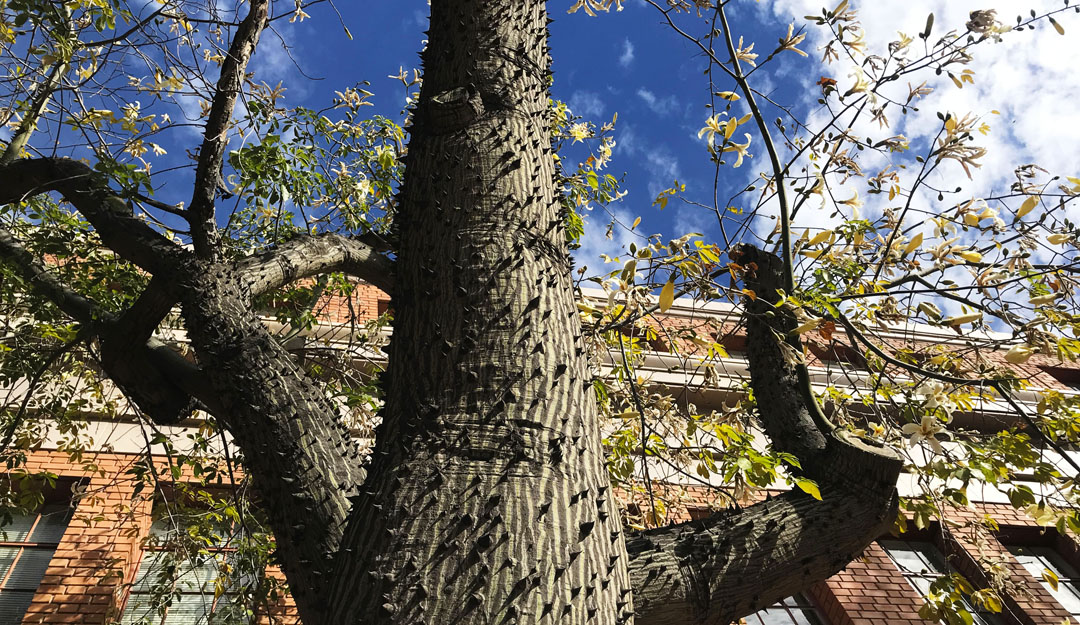
The Floss Silk Tree is one of the most-photographed trees on campus
From a distance, I noticed the large, beautiful white flowers, and up-close I was struck by the unique trunk, covered not only in green stripes (that help with photosynthesis) but also strange large thorns. Tapping on the trunk produces a hollow sound, and the thorns near the bottom of the trunk have been worn off due to decades of students and admirers like myself wanting to touch this strange tree.
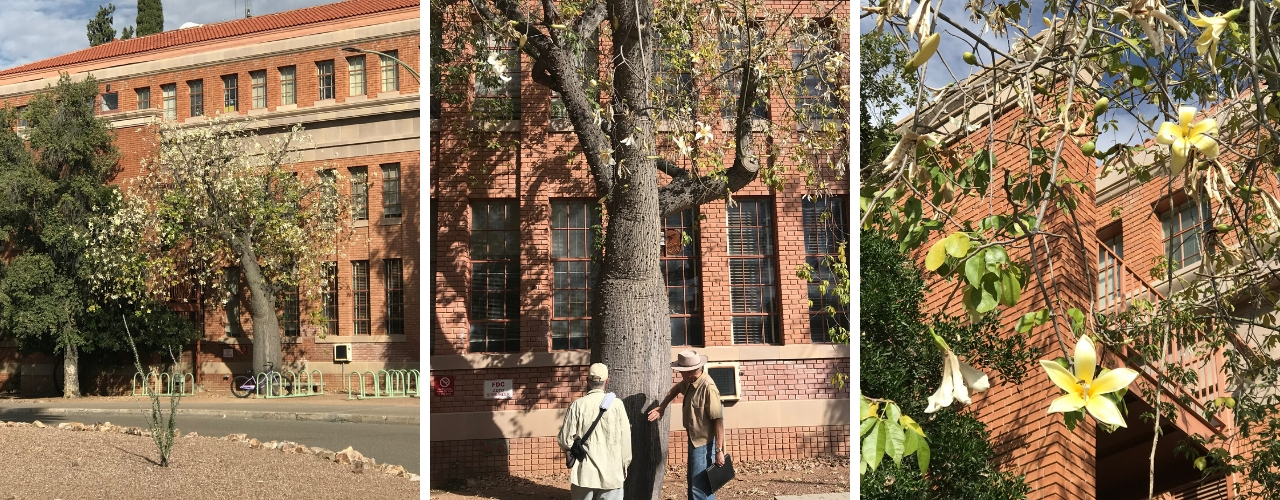
From left to right: the Floss Silk Tree from a distance, tapping on the trunk to produce a hollow sound, and a close-up of the beautiful magnolia-like flowers of the tree
I don’t see it on the PDF of the tour, so maybe this was extra information, but right next to the Floss Silk Tree I noted the beautiful yellow flowers of the Palo de Picho tree, native to Central America. The tall tree gracefully slanted away from one of the campus’s brick buildings and the yellow flowers seemed to pop against the dark blue sky.
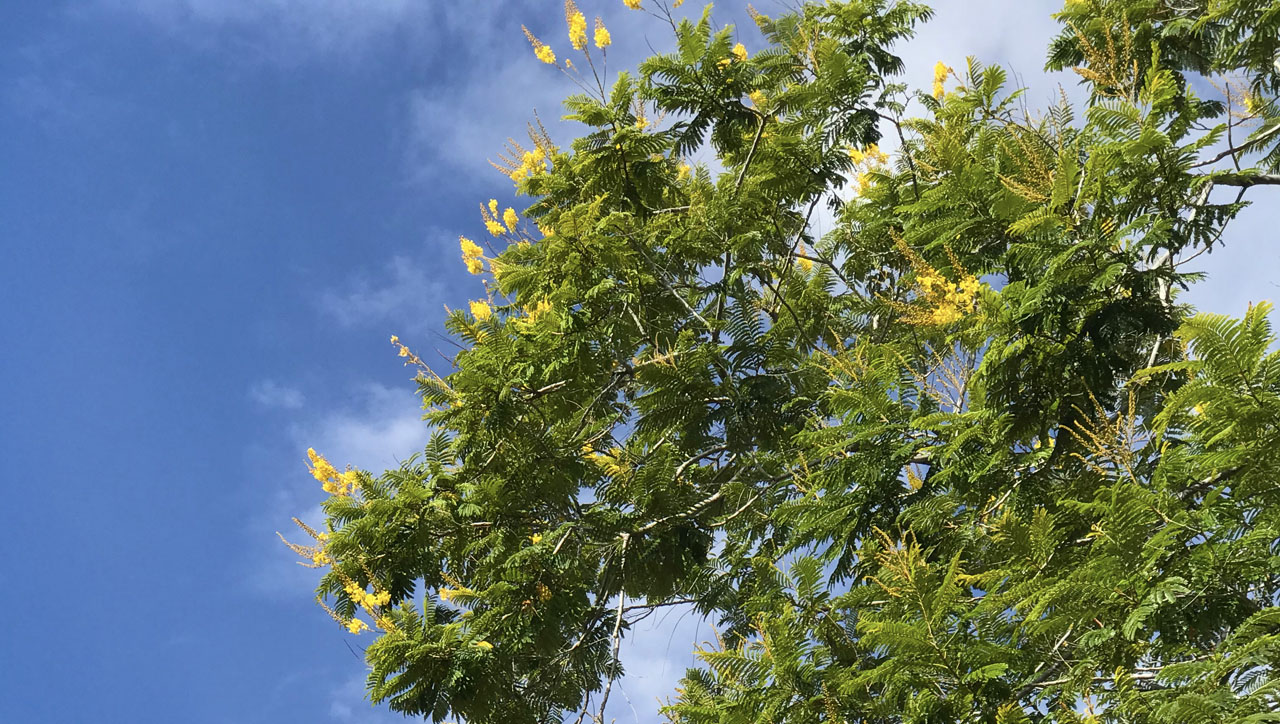
The yellow flowers of the Palo de Picho tree
Of course, not all of the trees flower in the fall like the Floss Silk Tree and the Palo de Picho, so my friend and I kept saying that we’ll need to plan another trip back to the campus in the spring, to see trees such as the Golden Rain Tree in bloom.
One that I would love to see adorned with flowers blooms in late winter and has been called “the most beautiful tree in the world,” the Orchid Tree. The leaves mimic the shape of camel hoof prints and the flowers resemble orchids (but are not actually orchids). Native to China, it doesn’t normally grow here but it has found a nice shady spot on campus and is well-watered. Our tour group was fascinated by the seed pods, which had dried into the shape of a spiral. We commented on how they reminded us of the native screwbean mesquite's pods.
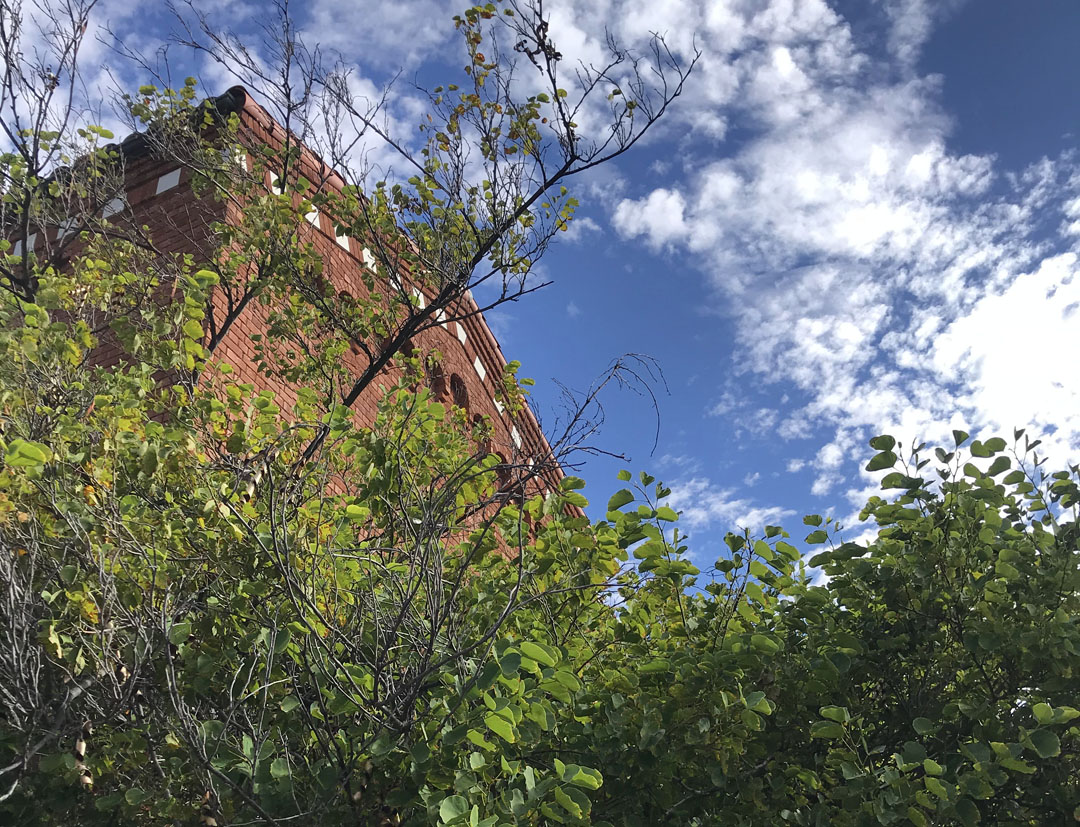
The Orchid Tree has leaves that resemble a camel hoof print
We also saw trees that will soon have beautiful fall colors. The Chinese Pistache grows some interesting green and red berries, which I joked meant that it was already decorating for Christmas. The Modesto Ash brought up an interesting discussion on Emerald Ash Borer (EAB), an invasive pest which (if you didn’t know) has already destroyed tens of millions of ash trees across the United States.
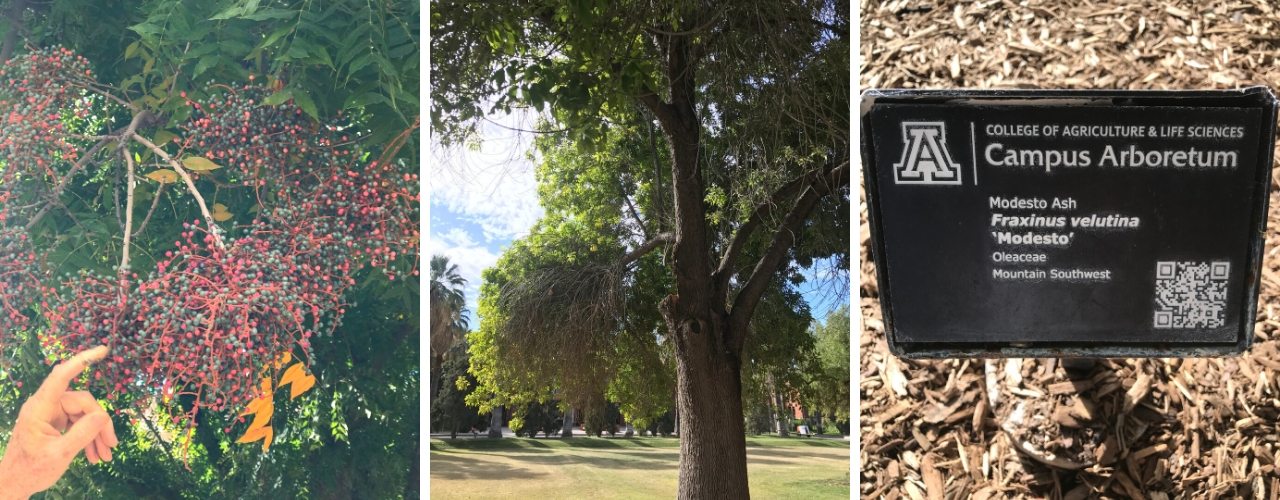
On left, the berries of the Chinese Pistache. Center is the Modesto Ash and right is a plaque describing it.
Some of the non-native trees we saw on the tour are now considered invasive in Tucson. An entire street on campus is lined with European olive trees, whose severe allergenic qualities have led to most types of olive trees being banned in Tucson. I did learn, however, that students and volunteers harvest the olives from these olive trees to make olive oil, which is sold in the UA Bookstore. I don’t particularly love olives (or the allergies that I suffer from the tree pollen), but I do love some good olive oil!
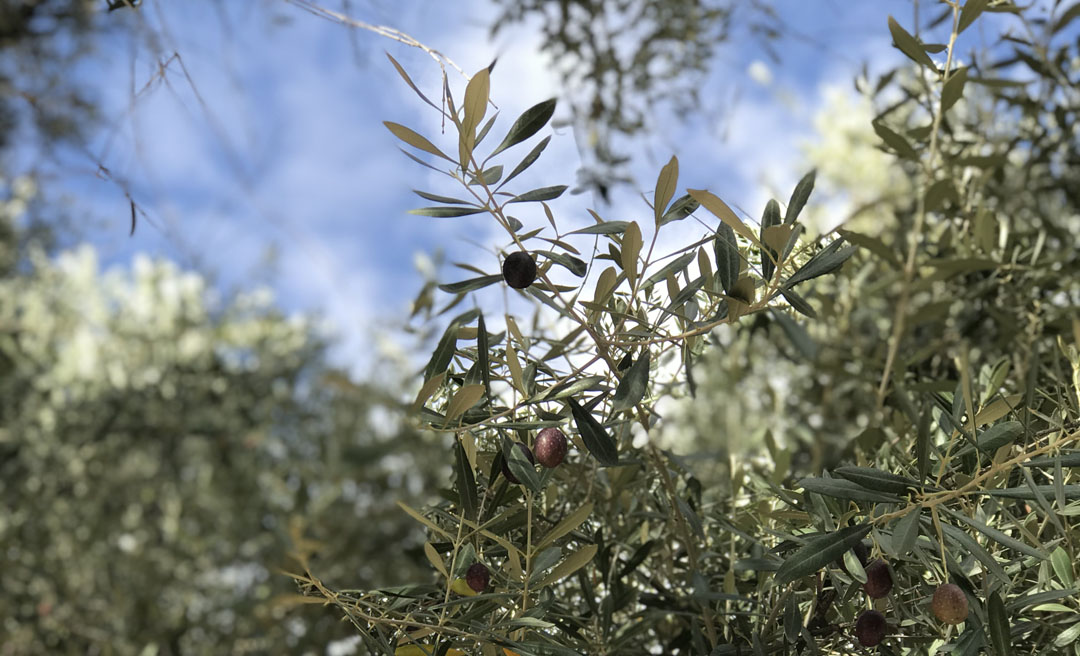
Did you know that black and green olives come from the same tree, they're just harvested at different times?
We also walked past a gnarled and twisted tree, which our guide remarked could easily be part of J.R.R. Tolkien’s Lord of the Rings. The tree turned out to be an African Sumac, one that I have some personal knowledge of, as one grows in my parents’ front yard in the Tucson area. African Sumac trees need more water than our native trees, and therefore their roots can become invasive. They also have quite messy seeds that (I can attest) get all over yards. As this tree is in the same family as poison ivy and cashews, some people have allergic reactions when they touch any part of the tree without gloves, and severe lung problems if they burn the wood or leaves and breathe in the smoke. It is considered an invasive weed and planting is discouraged (I would agree).
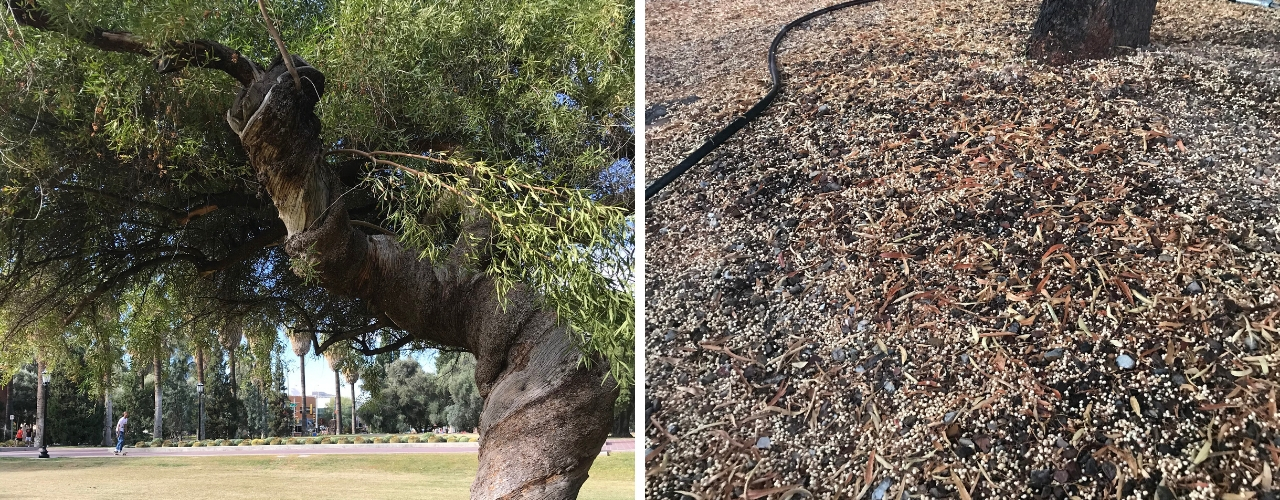
The twisted African Sumac tree on campus (L) and the mess that one can create in a Tucson yard (R)
There were several more trees that we observed and learned about – but I really recommend going on a tour yourself if at all possible. As I mentioned earlier, the tours are free (we had to pay for parking because of Homecoming weekend but my friend and I both agreed that it was worth it) and open to anyone.
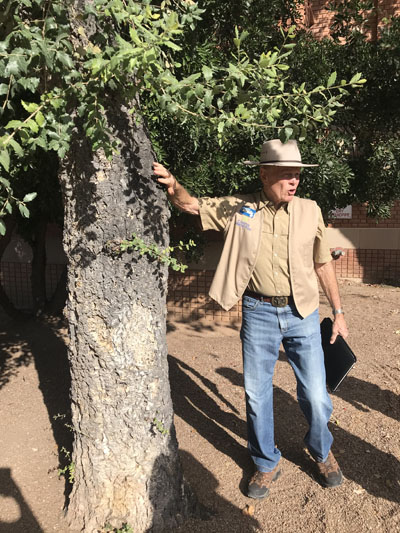
Tony, our volunteer Master Gardener guide, explaining how cork is harvested from cork oak trees
I spoke with our volunteer guide for a bit after the tour (his name was Tony Knight, I believe, and he did a great job!), and he asked me to mention that tours are also available for groups. So if you have a gardening group, for instance, and want to see specific parts of the arboretum, that can be arranged with a little advanced notice.
To me, it sounds like a great resource that not enough people are taking advantage of – along with my friend and I there were only two others on the tour – a very knowledgable, self-described "snowbird" couple that had visited arboretums all over but had not visited the one in Tucson until now. We all agreed that we would definitely try to come back for other tours. There’s one left this fall (on November 19) and then they start up again in March.
Maybe we’ll see you there?
How to register: Online via this form
When are the tours: Various dates in fall and spring
How long do the tours last: 60-90 minutes
What to bring: Walking shoes, water, a camera or camera phone, maybe a pen to take notes?
How much does it cost: FREE!
Note: If you're looking for trees that will work well in your Tucson yard, check out this post.